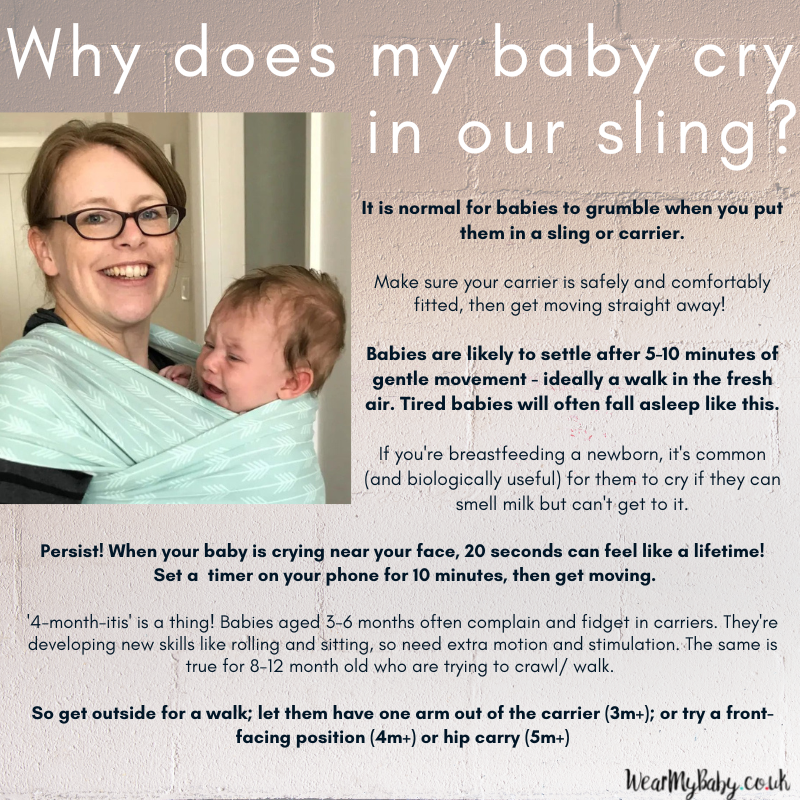We often hear from parents that “My baby doesn’t like slings”. Sometimes they’ve tried three or four slings with no luck. Yet most of the time we’re still able to find a great sling or carrier that is comfy for parents and that baby loves to be in.
Pretty much all babies love to be carried and it’s biologically normal. The key is finding the right sling and making sure you’re using it correctly, in a way that is comfy for you both. Then get moving!
Here’s how to settle your baby in a sling…
DON’T WORRY – IT’S NORMAL
It’s completely normal and very common for babies to fuss when they are being transferred from one place to another. In and out of car seats, clothes, nappies and slings – if your baby was comfy where they were they’ll likely react when their situation changes.
Many babies grumble while you’re putting them in a sling or carrier, but often settle after 5-10 minutes once they are safely secured and you get moving. If not then take a break to feed, play, relax and try again later.
THEY CAN SMELL MILK, BUT THEY CAN’T GET TO IT
If your newborn is hungry then they’ll be unlikely to settle in a sling. Especially if they’re breastfed, as they can smell your milk but can’t get to it!
(This is why they might settle faster on a caregiver who isn’t a breastfeeding mum.)
It’s so easy to underestimate how often newborns need to feed. Even if they recently fed, check for signs that your baby might still be hungry – these include being restless, shaking or nodding their head against you (rooting), opening and closing their mouth, or sucking their hands/anything close to their face.
4-MONTH-ITIS
Is your 3,4 or 5-month-old crying or fidgeting your carrier? Welcome to the Frustrated Fifth Trimester!
Babies of this age are particularly prone to be unsettled in the carrier, and need lots (sometimes constant) movement from you while being carried.
This often peaks around 4 months, hence ‘4-month-itis’. In short: they don’t hate their carrier, it’s just their age!
Are they pushing against your chest? This doesn’t mean they’re necessarily unhappy; they’re just moving as they would if they were tummy-down on a playmat.
They’re working those muscles and starting to develop the upper body strength they’ll need to master rolling and sitting up. As they want to motor themselves around, but can’t, they can get frustrated.
So get MOVING, ideally in the fresh. Sitting or standing still will be no fun for either of you! And remember: it’s a phase.

TRY A DIFFERENT POSITION
Newborns are usually happy snugged into your chest with their arms in the sling. From 4 months and up, babies will often prefer to be less restricted and want to look around.
Try using a carrier with an adjustable height, that allows them to ride with their arms and shoulders over the top so they can look around.
Or a supportive outwards facing carrier (from around 4 months), a hip carry (from 5-6 months) or a high back carry so they can see over your shoulder (usually 6 months+).
TRYING TO CRAWL OR WALK
Oh look, another phase! Around 8-12 months your baby is likely to start trying to crawl or pull themselves up to walking.
Why go in a carrier when they could be mastering these latest skills?!
If your baby is now doing acrobatic flips and loud protests to avoid going in a carrier, you may need to give them lots of playtime before popping them in (If possible).
Once your toddler is confidently walking, you’ll find the novelty wear off fairly quickly, and they’re likely to start asking to be carried once their little legs get tired.
GET WALKING
Newborns are used to movement in the womb; so they’ll be soothed by gentle swaying or, more often, a brisk walk. So make sure you’ve got your shoes on BEFORE you put them in the carrier, and get outside.
Fresh air makes a huge difference, as will the change of scene. This is also true to for older babies, who will love the sensory stimulation and distraction.
PERSIST
In a sling, crying and fussing is happening right in front of your face and close to your ears. So you’ll be far more aware of it than when you’re strapping them into a car seat or buggy.
Give it 5-10 mins of movement and they’re very likely to settle and/ or fall asleep. Tired babies are also more likely to fuss in a sling, but stick with it!
With a crying baby, 20 seconds might feel like 5 whole minutes… but it’s not! So time yourself if needed, and be as patient as you can.
With practice you’ll be able to get your carrier on quickly and without any fuss, making the whole process easy for you both.
CHECK YOUR CARRIER IS FITTED CORRECTLY
Babies like to feel safe. A sling that’s snug and tightly fitted well will support their spine and head, enabling them to relax. If they don’t feel supported then they won’t be able to settle as easily.
We often see parents who have loosened their carrier to give their baby more space to make them comfier. Actually, it has the opposite effect. In a loosely fitted baby carrier, your baby will feel less secure and will fuss more.
If you don’t seem to be able to get your sling to feel secure or if you always feel like you have to support your baby with your hands then you may need help (or a different sling) to get a safe fit.
Your baby should be held high and snug against your chest, close enough to kiss the top of their head; and with the carrier tightened to prevent them flopping or slumping away from your body.
GET IN TOUCH
Need more help? Get in touch or live chat with our team.


 ⭐⭐⭐⭐⭐
⭐⭐⭐⭐⭐
